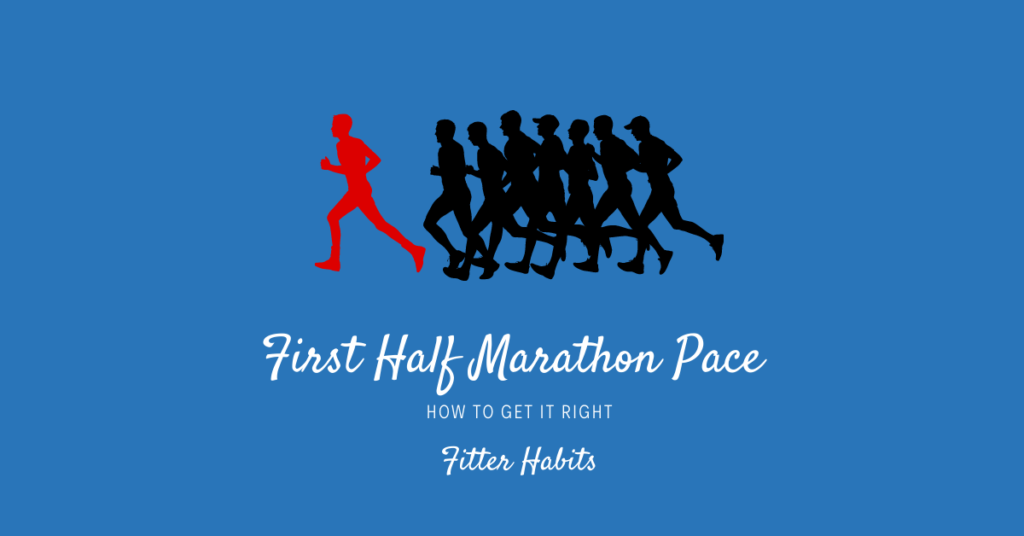Getting that first half marathon pace right is especially important when training for a half marathon.
Go out too slow at a short race, and you’ll miss out on a personal best. Go out too fast in a marathon, and you might not finish.
Finding an ideal half-marathon race pace depends on your aerobic capacity, race goals and training.
Contents
Finding Your Half-Marathon Race Day Pace

Usually, a half-marathon training plan takes place during the 12 weeks before the race. One of the most basic regimens to follow during this time is to run 10 miles or more three to four times a week.
These training runs should include easy runs, speed runs, and tempo runs. Strength training, cross-training, and working with different terrain are also integral for an excellent foundation.
Short runs, long runs, and interval sessions will build a solid aerobic base for any race. During training, Speedwork will also help with mental resiliency and determine what pace feels good and what pace feels like an all-out effort.
If you’re unsure, standards differ between male and female marathoners. According to Runner’s World:
- Typically, male runners have an average finishing time of 1:55:26.
- Untrained women, come in at closer at 2:11:57.
In short, determine your ideal pace during training first… and then stick to that pace on race day. These three strategies can help with that.
1. Body Awareness
Awareness of how your body reacts to flat surfaces versus trails will help you find a better pace. During one weekly run, train alone without music or other distractions. The solitude and silence will help you become more in tune with how your body moves and reacts to more comfortable and challenging environments.
You can take your time on these runs, paying attention to your breathing and the overall feeling in your legs and body. Alternatively, you can focus on tracking your perceived exertion level and your final pace to figure out the correlation between the two eventually.
2. Heart Rate
Determine your average race pace by using your heart rate.
A GPS watch or similar device allows you to track this information efficiently. For example, newer Garmin running watches like the 245 indicate what heart rate zone and effort level you’re training and even racing. Aim for:
- Zone one to two for recovery runs, easy runs, and the start of a half-marathon.
- Zone three for faster runs or the second half of a marathon.
- Zone four for a five K race or a tempo.
- Zone 5 for a maximal all-effort, sprint or the last one thousand meters of a half-marathon.
These watches can even predict finish times based on recent training efforts. I find these predictions optimistic. Keep in mind a watch is an indicator of an ideal goal pace, not a prescription.
3. A Race Goal
To establish a goal pace for reaching the finish line, consider factors like your:
- Age
- Course profile
- Health
- Biological sex
- Fitness level
- Training
- Outside influences, you will need to work with different paces.
Now, let’s cover the race itself.
First Half
If it’s your first race, start at a leisurely pace. Especially during the first mile or three of the race, it is essential to conserve as much energy as possible and run consistently.
For these first few miles, run five or ten seconds slower than your goal race pace. You can make this time up, later on.
When you reach the five-mile mark, increase your pace a bit. It helps to pick a group ahead of you to focus on. Try to meet their pace and use them as a point of focus.
Experienced runners may start faster, but trying to keep up is only a good idea if you have a personal best in mind and feel confident about your overall fitness levels.
Second Half
As the second half of the race, switch your focus to a runner ahead. This serves as a mini goal to beat, and it also helps you pace yourself with a runner of similar fitness levels.
Think confidently, use mantras, and throw in some running surges to make up for the time you saved at the beginning of the race.
The Finish Line
As you approach the finish line, expect a surge of adrenaline. Use this rush to fuel an increase in pace during the home stretch. It’s not uncommon to see many marathoners engaged in an all-sprint during the final few hundred meters.
First Half Marathon Pace: The Final Word
There’s a big difference between becoming a finisher and clocking in a personal best.
Finding a first half marathon pace that works require considering the course profile, your training and how you feel on the day. If it’s your first half marathon, listen to your body first.



